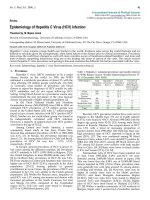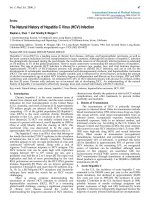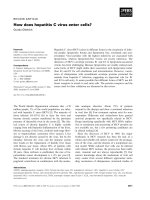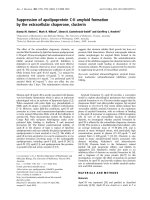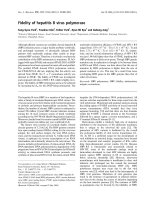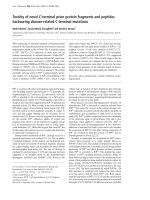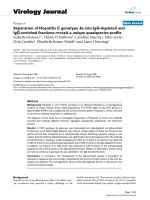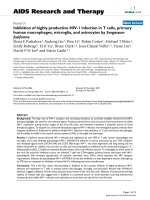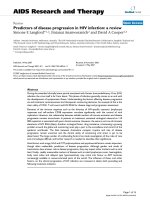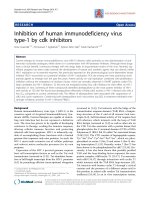Báo cáo y học: "Epidemiology of Hepatitis C Virus (HCV) Infection"
Bạn đang xem bản rút gọn của tài liệu. Xem và tải ngay bản đầy đủ của tài liệu tại đây (248.8 KB, 6 trang )
Int. J. Med. Sci. 2006, 3
41
International Journal of Medical Sciences
ISSN 1449-1907 www.medsci.org 2006 3(2):41-46
©2006 Ivyspring International Publisher. All rights reserved
Review
Epidemiology of Hepatitis C Virus (HCV) Infection
Theodore Sy, M. Mazen Jamal
Division of Gastroenterology, University of California, Irvine, CA 92868, USA
Corresponding address: M. Mazen Jamal, University of California Irvine, 101 The City Drive, Orange, CA 92868, USA.
Received: 2005.12.30; Accepted: 2006.03.23; Published: 2006.04.01
Hepatitis C virus remains a large health care burden to the world. Incidence rates across the world fluctuate and are
difficult to calculate given the asymptomatic, often latent nature of the disease prior to clinical presentation. Prevalence
rates across the world have changed as well with more countries aware of transfusion-related hepatitis C and more and
more evidence supporting intravenous drug use as the leading risk factor of spread of the virus. This article reviews
current hepatitis C virus prevalence and genotype data and examines the different risk factors associated with the virus.
Key words: Epidemiology, hepatitis C virus, blood transfusions, intravenous drug use
1. Prevalence
Hepatitis C virus (HCV) continues to be a major
disease burden on the world. In 1999, the WHO
estimated a worldwide prevalence of about 3% with the
virus affecting 170 million people worldwide. [1] (Table
1). Generally, most studies of prevalence use blood
donors to report the frequency of HCV usually by anti-
HCV antibodies and do not report follow-up HCV
testing. Using blood donors as a prevalence source may
underestimate the real prevalence of the virus because
donors are generally a highly selected population. [2]
In the Third National Health and Nutrition
Examination Survey (NHANESIII) from 1988 to 1994, an
estimated HCV prevalence of 3.9 million people was
found in the United States (US) with 2.7 million people
found to have chronic infection with HCV (positive HCV
RNA). Neither sex nor racial-ethnic group was found to
be independently correlated with HCV infection.
However, a majority of patients that were HCV positive
were below the age of 50. [2]
Among Central and South America, a recent
community based study in San Juan, Peurto Rico,
showed that estimated prevalence of HCV in 2001-2002
was 6.3%. [3] In Mexico, the prevalence reported was
about 1.2%. (4) Among blood donors in Chile and Brazil,
prevalence of HCV Ab was low - 0.3%, 1.14%
respectively. [5,32]
In Europe, general prevalence of HCV is about 1%
but varies among the different countries. [6] Prevalence
of HCV antibody is 0.87% (1993-1994) in Belgium. [7] In
the United Kingdom, at least 200,000 adults carry HCV.
[8] In Northern Italy, prevalence of HCV Ab was 3.2%.
[9] Three studies in Central and Southern Italy showed a
higher rate of HCV (8.4%-22.4%), especially in the older
population. [10-12] Among patients of general
practitioners in Lyon, France, the prevalence of HCV was
estimated to be 1.3%, very similar to the French general
population. [13] Within the Russian army, frequency of
anti-HCV was 1.5% among servicemen and donors with
increased prevalence in the North Caucasus, Far East
and Siberia (3.1-3.8%) compared to the Transbaikal
region (0.7%). [14] Low rates were found in Hungary
(0.73% of 15,864 blood donors.) [31]
Table 1: Hepatitis C estimated prevalence and number infected
by WHO Region. Source: Weekly Epidemiological Record. N°
49, 10 December 1999, WHO.
WHO Region Total
Population
(Millions)
Hepatitis C
prevalence
Rate %
Infected
Population
(Millions)
Number-of
countries by
WHO Region
where data are
not available
Africa 602 5.3 31.9 12
Americas 785 1.7 13.1 7
Eastern
Mediterranean
466
4.6 21.3 7
Europe 858 1.03 8.9 19
South-East Asia 1 500 2.15 32.3 3
Western Pacific 1 600 3.9 62.2 11
Total 5 811 3.1 169.7 57
Recently, HCV prevalence studies have come out of
Pakistan in the Middle East. 751 out of 16,400 patients
(4.57%) were found to +HCV Ab from 1998-2002 with the
largest age group from 41-50. [15] Among male blood
donors in Karachi, Pakistan, the seroprevalence of HCV
was 1.8% with a trend of increasing proportion of
positive donors from 1998-2002. [16] There has been very
high prevalence rates of HCV reported in Egypt in the
past (28%). [17] This was confirmed among 90 blood
donors in Cairo, where 14.4% were anti-HCV positive by
RIBA test. [18] Then 26.6% among 188 blood donors and
22% among 163 donors were positive with both studies
done in Cairo. [19, 20] Rates were lower in Saudi Arabia
(1.8%) and Yemen (2.1%). [33, 34]
Intermediate rates of HCV have been reported out
of Asia. From 1995-2000, 0.49% anti-HCV Ab were
detected among 3,485,648 blood donors in Japan. [44]
This was lower than the 0.98% our of 10,905,489 blood
donors reported in 1992. [21] In China, prevalence rates
were generally low with rates around 1% among donors
in Beijing and Wuhan. [22, 23] However, rates may be
higher in certain areas such as the Hubei province
(30.13%) and Inner Mongolia Autonomous Region
(31.86%). [24] Low rates have been found in Malaysia
(around 1.6%) and Singapore (0.54%). [25.26] Higher
rates of HCV have been found in Thailand (3.2-5.6%).
[27, 28] Within a smaller community of 103 residents in
Sherpas, Nepal, only 1 person had a borderline reaction
Int. J. Med. Sci. 2006, 3
42
in 2004. [29] In New Delhi, India, 1.85% of blood donors
were positive. [30]
There have been fewer studies out of Africa, but
lower rates have been reported – 1.6% among blood
donors in Ethiopia and 0.9% in Kenya. [35, 36]
The estimated prevalence in Australia has been
recently reported as 2.3% with the virus affecting 210,000
people by 2001. The 20-24 year old age group had the
highest prevalence with strong majority of the infected
population below the age of 50. [37]
2. Risk Factors
Intravenous drug use
Transmission of Hepatitis C virus has been strongly
associated with intravenous and percutaneous drug and
needle use. Reported cases of hepatitis C from
intravenous drug use is on the rise in the US. In a study
of injection drug users in Baltimore, Maryland from 1988
to 1996, 30.3% of participants developed anti-HCV
antibodies with most in the first 2 years of the study. [38]
Among 310 drug users in Antwerp and Limburg in
Belgium, 71% and 46% had anti-HCV antibody,
respectively. [39] The Hepatitis C European Network for
C-operative Research (HENCORE) group reported a
prevalence of hepatitis C of 80% among intravenous
drug users (IVDU). [6] In the District Buner study in
Pakistan, all 751 anti-HCV patients had a history of
injections. [15] 90% of IVDU in Chang Rai, Thailand were
positive for HCV. [27] 36.6% of randomly selected IVDU
in Sydney, Australia and 74% of IVDU in Melbourne,
Australia were HCV positive. [42,43] A recent study in
London, England took 428 intravenous drug users below
the age of 30 and found that 44% had antibodies to
hepatitis C compared to 4% with HIV. This came out to
an incidence of 41.8 cases per 100 person years of
antibody to HCV. [40]
The importance of intravenous drug use can not be
overemphasized. The prevalence of HCV among people
who acquired HIV through intravenous drug use reaches
90%. [41] Co-infection of the two viruses can make
treatment all the more difficult. Most countries with a
young population of HCV infection must deal with
intravenous drug use as the leading cause for spread of
the virus. Many of these intravenous drug users do not
know they are infected. Screening of HCV and treatment
of substance abuse are extremely important in this
group.
Blood Transfusions
Transfusion of blood products has been a leading
cause of transmission of HCV; however, due to
improved screening, transmission through transfusions
has decreased in most developed countries. In Japan,
incidence of post-transfusion non-A non-B hepatitis
among those with less than 10 transfusions dropped
from 4.9% (1988-Oct ‘89) to 1.9% (Nov’89-90) after
screening with first-generation anti-HCV test was
introduced. [45] In the US, incidence of post-transfusion
hepatitis C dropped from 3.84% to 0.57% per patient
(0.03% per unit blood) after HCV screening was
introduced in 1990. [46] In England, the frequency HCV
infected donations dropped from 1 in 520,000 (1993-98)
to 1 in 30 million (1999-2001) when donations were tested
for HCV RNA. [47]
However, incidence of transfusion related hepatitis
C is still higher in other areas of the world. In a study of
147 Chilean patients with chronic hepatitis C, the most
common risk factor was blood transfusion in 54% versus
just 5% with IVDU. [48] A study was done in the largest
blood bank in Santa Catarina, Brazil from 1991-2001
showing a significant drop in risk of acquiring HCV, but
the lowest risk of 1:13721 was still almost 10 times higher
than that of developed countries. [49] Despite better
screening for selecting blood donors, there remains a
need for some kind of HCV screening laboratory test.
Sexual activity
The role of sexual activity in the transmission of
HCV remains unclear. In the NHANESIII study, number
of sexual partners (OR 2.54 for 2-49 partners) and age at
first sexual intercourse (OR 2.94) had significant
correlation with HCV Ab and this has been confirmed in
other studies. [2,3] Among 1257 non-IVDU in Baltimore
at a STD clinic 9.7% were positive for HCV. [50] One
hypothesis is that many of the hepatitis C patients may
have injecting sexual partners. In one study, 15% of non
IVDU women with an injecting partner had HCV. [51]
More recently, a 10-year prospective follow-up study
(8060 person-years) showed no evidence of sexual
transmission among monogamous couples in Italy. [52]
However, in a study among spouses in Egypt, it was
estimated that wife to husband transmission was 34%
and 10% among women with and without detectable
HCV RNA. Husband to wife transmission was estimated
at 3%. Overall, 6% were estimated to have contracted
HCV from their spouse. [53] One most remember
however that the prevalence of HCV is much higher in
Egypt and this study did not emphasize monogamous
relationships and transmission between spouses can only
be assumed to be sexual in nature. Also recently, there
was lack of evidence found for sexual transmission of
HCV among men who have sex with men in the
prospective ongoing Omega Cohort Study in the US
(2653 person-years of follow-up). [54] All of this new
evidence supports that sexual transmission of HCV is
still rare but for some reason is higher among those with
high-risk sexual activity.
Hemodialysis
It has been well documented that dialysis patients
have a higher rate of HCV infection. In the 90’s much of
the world reported anti-HCV prevalence rates of 10-50%
among hemodialysis patients with lower rates in such
places as Ireland (1.7%). [55-60] Previously, rates in
Europe were as high as 20-30%. [6] A more recent report
from Saudi Arabia showed a prevalence rate of HCV
among hemodialysis patients to be 9.24% compared to
0.30% among blood donors. [61] In a tertiary-care
hospital in Mexico City, Mexico, the rate of anti-HCV
was 6.7% compared to the roughly 1.2% prevalence in
the population of Mexico. [62] The rate of seroconversion
among hemodialysis patients with no other risk factors
has been reported 1.38-1.9%/year. [63,64] These studies
generally conclude that the transmission of the virus to
hemodialysis patients is generally nosocomial with
possible risk factors being failure to disinfect devices
between patients, sharing of single-use vials for
infusions, poor sterile technique, poor cleaning of
dialysis machines, and poor distance between chairs. [65]
Int. J. Med. Sci. 2006, 3
43
Special Populations
The prevalence of HCV has been noted to be higher
in other populations as well. Among kidney transplants,
the prevalence was reported to be as high as 33.3% in
Italy with the frequency higher prior to 1990(50%) than
after 1990 (27%). [66] Obviously, most of these kidney
transplant patients underwent dialysis as well.
The United States Veteran Affairs medical centers
have also reported a higher prevalence of HCV than the
general population with percentages as high as 35% in
the VA Palo Alto system. [67] The most recent study
among 20 centers reported an estimated prevalence of
5.4% with 78% reporting a risk factor of either
transfusion or intravenous drug use. Seropositivity was
also associated with tattoo use and incarceration in this
study. [68]
There is also an increased prevalence of HCV also
among prison inmates. One example is the Riverside
county jail system where 25% adults incarcerated carried
the virus while only 2% of the juvenile detention
population carried HCV. [69] The juvenile detention
population therefore provides a target for teaching and
intervention since many of these juveniles acquire the
virus early in their adult years.
3. Genotypes of HCV
HCV is divided among six genotypes with
numerous subtypes. These genotypes can differ up to
30% from each other in nucleotide sequence. Depending
on the HCV genotype, length of treatment can differ.
Genotype 1b is less responsive to alpha-interferon
therapy compared to genotypes 2 and 3. It is therefore
important to track the different genotypes of the HCV
virus. In the NHANESIII study done in the US, 56.7%
were classified as 1a, 17% as 1b, 3.5% as 2a, 11.4% as 2b,
7.4% as 3a, 0.9% as 4, 3.2% as type 6. [2] 50% of all
infections were by genotype 1 with a higher percentage
of genotype 3 among the IVDU population in England.
[70,71] Genotype 1b was the predominant genotype (46%
among blood donors) in Chile and was found in all
infected patients with hepatocarcinoma in one study. [5]
This same genotype was also found in 82% of 147 chronic
hepatitis C patients in Chile as well. [48] Genotype 1b is
also dominant in Japan. [72-74] In Beijing, China, of 63
HCV-RNA samples, 52% were genotype 2 and 29% type
3. [22] In Thailand, HCV 3a was the most common
genotype at 50-60% with 1a, 1b, and 6 comprising the
rest (10-20% each). [27] Out of 90 patients in Estonia,
73.3% carried 1b, 20% with 3a, and 6.7% with 2a. [75]
Genotype 3 is most common on the Indian subcontinent
while genotype 4 is the most common genotype in Africa
and the Middle East. [76-80] Genotype 5 can be found in
South Africa and as mentioned above, genotype 6 can be
found in south-east Asia. [81,82]
4. Prevention
Primary prevention of hepatitis C should target
reduction of transmission of the virus. Prevention should
target those at risk of acquiring the virus and should
involve providing education, risk reduction counseling,
HCV screening and substance abuse treatment. In the
US, the Centers for Disease Control (CDC) suggest
screening for the follow population:
• Persons who ever injected illegal drugs, including those
who injected once or a few times many years ago.
• Persons who received a blood transfusion or organ
transplant before July 1992.
• Persons who received clotting factor concentrates before
1987.
• Persons who were ever on long-term dialysis.
• Children born to HCV-positive women.
• Healthcare, emergency medical, and public safety workers
after needlesticks, sharps, or mucosal exposures to HCV-
positive blood.
• Persons with evidence of chronic liver disease.
Extra attention should be given to populations in
specific settings such as correctional institutions, drug
treatment programs, programs for high risk youth, HIV
counseling and testing sites, and STD clinics. In these
settings, physicians should always screen for intravenous
drug use. Unlike HIV, HCV is found in high
concentrations in filters, spoons, and rinsing liquids that
may be used in association with needle drug use.
Patients should be counseled on contaminated
equipment being a source of infection. Addiction care
and counseling should be focused on with possible
referrals for psychotherapy and detoxification. [83-85]
Prevention in healthcare setting should also take
place by having better sterilization, safer injections,
reducing opportunities for percutaneous exposures to
blood. In developing countries, better screening for
donors and blood screening should take place to reduce
the number of transfusion related transmissions.
Once a patient is found to have hepatitis C, that
patient needs to be counseled to reduce the risk of HCV
transmission to others. The physician should also offer
counseling on treatment, reducing alcohol usage and
immunization with hepatitis A, hepatitis B,
pneumococcal and influenza vaccines. HCV negative
persons with ongoing risk factors also require counseling
and immunization with hepatitis A and hepatitis B
vaccines. [83-85]
Future research in this field will need to be
continued. We will need to continue to evaluate the
incidence of the virus third world countries as well as the
transmissibility of the various genotypes. Better
prevention, screening and treatment methods for
Hepatitis C virus all need to be elucidated.
Conflict of interest
The authors have declared that no conflict of interest
exists.
References
1. WHO. Global surveillance and control of hepatitis C. Report of a
WHO Consultation organized in collaboration with the Viral
Hepatitis Prevention Board, Antwerp, Belgium. J Viral Hepat
1999;6:35–47
2. Alter MJ, Kruszon-Moran D, Nainan OV, McQuillan GM, Gao F,
Moyer LA, Kaslow RA, Margolis HS. The prevalence of hepatitis C
virus infection in the United States, 1988 through 1994. N Engl J
Med 1999; 341:556-62
3. Perez CM, Suarez E, Torres EA, Roman K, Colon V. Seroprevalence
of hepatitis C virus and associated risk behaviours: a population-
based study in San Juan, Puerto Rico. Int J Epidemiol. 2005;
34(3):593-9
4. Uribe M, Mendez-Sanchez N. Hepatitis C in Mexico. Rev
Gastroenterol Mex. 2002; 67:S7-S8.
5. Munoz G, Velasco M, Thiers V, Hurtado C, Brahm J, Larrondo-Lillo
M, Guglielmetti A, Smok G, Brechot C, Lamas E. Prevalence and
genotypes of hepatitis C virus in blood donors and in patients with
Int. J. Med. Sci. 2006, 3
44
chronic liver disease and hepatocarcinoma in a Chilean population.
Rev Med Chil. 1998; 126(9):1035-42.
6. Touzet S, Kraemer L, Colin C, Pradat P, Lanoir D, Bailly F, Coppola
RC, Sauleda S, Thursz MR, Tillmann H, Alberti A, Braconier JH,
Esteban JI, Hadziyannis SJ, Manns MP, Saracco G, Thomas HC,
Trepo C. Epidemiology of hepatitis C virus infection in seven
European Union countries: a critical analysis of the literature.
HENCORE Group (Hepatitis C European Network for Cooperative
Research). Eur J Gastroenterol Hepatol 2000; 12:667-678.
7. Van Damme P, Thyssen A, Van Loock F. Epidemiology of hepatitis
C in Belgium: present and future. Acta Gastroenterol Belg 2002; 65:
78-79.
8. [Internet] Department of Health: UK. Hepatitis C strategy for
England. 2002.
9. Bellentani S, Tiribelli C. The spectrum of liver disease in the general
population: lesson from the Dionysos study. J Hepatol 2001; 35:531-
7.
10. Stroffolini T, Menchinelli M, Dambruoso V, Menniti Ippolito F,
Costantino A, Rapicetta M, Lecce R, Taliani G. High prevalence of
hepatitis C virus infection in a small central Italian town: lack of
evidence of parenteral exposure. Ital J Gastroenterol 1995; 27:235-8.
11. Raffaele A, Valenti M, Iovenitti M, Matani A, Bruno ML, Altobelli E,
D'Alessandro A, Barnabei R, Leonardis B, Taglieri G. High
prevalence of HCV infection among the general population in a
rural area of central Italy. Eur J Epidemiol 2001; 17:41-6.
12. Maio G, d'Argenio P, Stroffolini T, Bozza A, Sacco L, Tosti ME,
Intorcia M, Fossi E, d'Alessio G, Kondili LA, Rapicetta M, Mele A.
Hepatitis C virus infection and alanine transaminase levels in the
general population: a survey in southern Italian town. J Hepatol
2000; 33:116-20.
13. Pradat P, et al. Prevalence of hepatitis C infection among general
practice patients in the Lyon area, France. Eur J Epidemiol.
2001;17(1):47-51.
14. Ogarkov PI, Malyshev VV, Tokmakov VS, Smirnov AV.
Epidmiological features of virus hepatitis in the Russian army.
Minerva Gastroenterol Dietol 2004; 50: 165-9.
15. Muhammad N, and Jan MA. Frequency of Hepatitis C in Buner,
NWFP. JCPSP 2005, 15 (1): 11-14.
16. Aktar S, Younus M, Adil S, Jafri SH, Hassan F. Hepatitis C virus
infection in asymptomatic male volunteer blood donors in Karachi,
Pakistan. J Viral Hepat. 2004; 11(6):527-35.
17. Saeed AA, al-Admawi AM, al-Rasheed A, Fairclough D, Bacchus R,
Ring C, Garson J. Hepatitis C virus in Egyptian blood donors in
Riyadh. Lancet 1991; 33: 359-60.
18. Darwish NM, et al. Hepatitis C virus infection in blood donors in
Egypt. J Egypt Public Health Assoc. 1992; 67(3-4):223-36.
19. Bassily S, Hyams KC, Fouad RA, Samaan MD, Hibbs RG. A high
risk of hepatitis C infection among Egyptian blood donors: the role
of parenteral drug abuse. Am J Trop Med Hyg. 1995; 52(6):503-5.
20. Darwish MA, Raouf TA, Rushdy P, Constantine NT, Rao MR,
Edelman R. Risk factors associated with a high seroprevalence of
hepatitis C virus infection in Egyptian blood donors. Am J Trop
Med Hyg. 1993; 49(4):440-7.
21. Yamaguchi K, Kiyokawa H, Machida J, Obayashi A, Nojiri N, Ueda
S, Takatsuki K. Seroepidemiology of hepatitis C virus infection in
Japan and HCV infection in haemodialysis patients. FEMS
Microbiol Rev 1994;14:253–258
22. Wang Y, Tao QM, Zhao HY, Tsuda F, Nagayama R, Yamamoto K,
Tanaka T, Tokita H, Okamoto H, Miyakawa Y, et al. Hepatitis C
virus RNA and antibodies among blood donors in Beijing. J
Hepatol 1994;21: 634–640
23. Zhang YY, Hansson BG, Widell A, Nordenfelt E. Hepatitis C virus
antibodies and hepatitis C virus RNA in Chinese blood donors
determined by ELISA, recombinant immunoblot assay and
polymerase chain reaction. APMIS 1992;100:851–855
24. Tang S. Seroepidemiological study on hepatitis C virus infection
among blood donors from various regions in China. Chin J
Epidemiol 1993;14:271–274
25. Duraisamy G, Zuridah H, Ariffin MY. Prevalence of hepatitis C
virus antibodies in blood donors in Malaysia. Med J Mal 1993;48:
313–316
26. Kuperan P, Choon AT, Ding SH, Lee G. Prevalence of antibodies to
hepatitis C virus in relation to surrogate markers in a blood donor
population in Singapore. Southeast Asian J Trop Med Pub Health
1993;24(Suppl 1):127–129
27. Apichartpiyakul C, Apichartpiyakul N, Urwijitaroon Y, Gray J,
Natpratan C, Katayama Y, Fujii M, Hotta H. Seroprevalence and
subtype distribution of hepatitis C virus among blood donors and
intravenous drug users in northern/ northeastern Thailand. Jpn J
Infect Dis 1999;52:121–123
28. Songsivilai S, Jinathongthai S, Wongsena W, Tiangpitayakorn C,
Dharakul T. High prevalence of hepatitis C infection among blood
donors in northeastern Thailand. Am J Trop Med Hyg 1997;57:66–
69
29. Chiba H, Takezaki T, Neupani D, Kim J, Yoshida S, Mizoguchi E,
Takeuchi J, Suzuki J, Tanaka Y, Ito K, Kitamura T, Kuriki K, Wakai
K, Samejima K, Sonoda S, Tajima K. An epidemiological study of
HBV, HCV, and HTLV-1 in Sherpas of Nepal. Asian Pac J Cancer
Prev. 2004; 5(4):370-3.
30. Panigrahi AK, Panda SK, Dixit RK, Rao KV, Acharya SK, Dasarathy
S, Nanu A. Magnitude of hepatitis C virus infection in India:
prevalence in healthy blood donors, acute and chronic liver
diseases. J Med Virol 1997;51:167–174
31. Barna TK, Ozsvar Z, Szendrenyi V, Gal G. Hepatitis C virus
antibody in the serum of blood donors. Orvosi Hetilap 1996;
137:507–511
32. Vasconcelos HC, Yoshida CF, Vanderborght BO, Schatzmayr HG.
Hepatitis B and C prevalences among blood donors in the south
region of Brazil. Mem Inst Oswaldo Cruz 1994, 89: 503–507
33. Al-Faleh FZ, Ramia S, Arif M, Ayoola EA, al-Rashed RS, al-Jeffry M,
Hossain A, el-Hazmi M. Profile of hepatitis C virus and the possible
modes of transmission of the virus in the Gizan area of Saudi
Arabia: a community-based study. Ann Trop Med Parasitol
1995;89:431–437
34. El Guneid AM, Gunaid AA, O’Neill AM, Zureikat NI, Coleman JC,
Murray-Lyon IM. Prevalence of hepatitis B, C and D virus markers
in Yemeni patients with chronic liver disease. J Med Virol
1993;40:330–333.
35. Frommel D, Tekle-Haimanot R, Berhe N, Aussel L, Verdier M,
Preux PM, Denis F. A survey of antibodies to hepatitis C virus in
Ethiopia. Am J Trop Med Hyg 1993;49:435–439
36. Ilako FM, McLigeyo SO, Riyat MS, Lule GN, Okoth FA, Kaptich D.
The prevalence of hepatitis C virus antibodies in renal patients,
blood donors and patients with chronic liver disease in Kenya. East
Afr Med J 1995;72:362–364
37. Amin J, Gidding H, Gilbert G, Backhouse J, Kaldor J, Dore G,
Burgess M. Hepatitis C prevalence – a nationwide serosurvey.
Commun Dis Intell. 2004; 28(4):517-21.
38. Villano SA, Vlahov D, Nelson KE, Lyles CM, Cohn S, Thomas DL.
Incidence and risk factors for hepatitis C among injection drug
users in Baltimore, Maryland. J Clin Microbiol 1997;35:3274–3277
39. Mathei C, Robaeys G, van Damme P, Buntinx F, Verrando R.
Prevalence of hepatitis C in drug users in Flanders: determinants
and geographic differences. Epidemiol. Infection 2005; 133: 127-136
40. Judd A, Hickman M, Jones S, McDonald T, Parry JV, Stimson GV,
Hall AJ. Incidence of hepatitis C virus and HIV among new
injecting drug users in London: prospective cohort study. BMJ
2005; 330:24-5.
41. Sulkowski MS, Thomas DL. Hepatitis C in the HIV-infected person.
Ann Intern Med 2003; 138:197-207.
42. Maher L, Chant K, Jalaludin B, Sargent P. Risk behaviours and
antibody hepatitis B and C prevalence among injecting drug users
in south-western Sydney, Australia. J Gastoenterology Hepatology.
2004; 19(10):1114-20.
43. Bradshaw CS, Pierce LI, Tabrizi SN, Fairley CK, Garland SM.
Screening drug users for sexually transmitted infections and blood
borne viruses using street outreach and self collected sampling. Sex
Transm Infect. 2005; 81(1):53-8.
44. Tanaka J, Kumagai J, Katayama K, Komiya Y, Mizui M, Yamanaka
R, Suzuki K, Miyakawa Y, Yoshizawa H. Sex- and age-specific
carriers of hepatitis B and C viruses in Japan estimated by the
prevalence in the 3,485,748 first-time blood donors during 1995-
2000. Intervirology. 2004; 47(1):32-40.
Int. J. Med. Sci. 2006, 3
45
45. Japanese Red Cross Non-A Non-B Hepatitis Research Group. Effect
of screening for hepatitis C virus antibody and hepatitis B core
antibody on incidence of post-transfusion hepatitis. Lancet
1991;338:1040–1041
46. Donahue JG, Munoz A, Ness PM, Brown DE Jr, Yawn DH,
McAllister HA Jr, Reitz BA, Nelson KE. The declining risk of post-
transfusion hepatitis C virus infection. N Engl J Med 1992;327:369–
373
47. Soldan K, Barbara JA, Ramsay ME, Hall AJ. Estimation of the risk of
hepatitis B virus, hepatitis C virus and human immunodeficiency
virus infectious donations entering the blood supply in England,
1993-2001. Vox Sang. 2003; 84(4):274-86.
48. Soza, A, Arrese M, Gonzalez R, Alvarez M, Perez RM, Cortes P,
Patillo A, Riquelme A, Riquelme A. Clinical and epidemiological
features of 147 Chilean patients with chronic hepatitis C. Ann
Hepatol. 2004; 3(4):146-51.
49. Kupek E. Transfusion risk for hepatitis B, hepatitis C, and HIV in
the State of Santa Catarina, Brazil, 1991-2001. The Brazilian Journal
of Infectious Diseases 2004; 8(3):236-240.
50. Thomas DL, Cannon RO, Shapiro CN, Hook EW 3rd, Alter MJ,
Quinn TC. Hepatitis C, hepatitis B, and human immunodeficiency
virus infections among non-intravenous drug-using patients
attending clinics for sexually transmitted diseases. J Infect Dis 1994;
169:990-995.
51. Goldberg D, McIntyre PG, Smith R, Appleyard K, Dunlop J, Taylor
A, Hutchinson S. Hepatitis C virus among high and low risk
pregnant women in Dundee: unlinked anonymous testing. Br J
Obstet Gynaecol 2001; 108: 365-370.
52. Vandelli C, Renzo F, Romano L, Tisminetzky S, De Palma M,
Stroffolini T, Ventura E, Zanetti A. Lack of evidence of sexual
transmission of hepatitis C among monogamous couples: results of
a 10-year prospective follow-up study. Am J Gastroenterol. 2004;
99(5): 855-9.
53. Magder, Fix AD, Mikhail NN, Mohamed MK, Abdel-Hamid M,
Abdel-Aziz F, Medhat A, Strickland GT. Estimation of the risk of
transmission of hepatitis C between spouses in Egypt based on
seroprevalence data. International Journal of Epidemiology 2005;
34:160-165.
54. Alary M, Joly JR, Vincelette J, Lavoie R, Turmel B, Remis RS. Lack of
evidence of sexual transmission of hepatitis C virus in a prospective
cohort study of men who have sex with men. American Journal of
Public Health. 2005, 95(3):502-5.
55. Niu MT, Coleman PJ, Alter MJ. Multicenter study of hepatitis C
virus infection in chronic hemodialysis patients and staff. Am J
Kidney Dis 1993;22:568–573
56. Conlon PJ, Walshe JJ, Smyth EG, McNamara EB, Donohoe J,
Carmody M. Lower prevalence of anti-hepatitis C antibody in
dialysis and renal transplant patients in Ireland. Irish J Med Sci
1993;162:145–147
57. Medin C, Allander T, Roll M, Jacobson SH, Grillner L.
Seroconversion to hepatitis C virus in dialysis patients: a
retrospective and prospective study. Nephron 1993;65:40–45
58. Hardy NM, Sandroni S, Danielson S, Wilson WJ. Antibody to
hepatitis C virus increases with time on hemodialysis. Clin Nephrol
1992;38:44–48
59. Nordenfelt E, Lofgren B, Widell A, Hansson BG, Zhang YY,
Hagstam KE, Kurkus J. Hepatitis C virus infection in hemodialysis
patients in Southern Sweden: epidemiological, clinical, and
diagnostic aspects. J Med Virol 1993;40:266–270
60. Hayashi J, Yoshimura E, Nabeshima A, Kishihara Y, Ikematsu H,
Hirata M, Maeda Y, Kashiwagi S. Seroepidemiology of hepatitis C
virus infection in hemodialysis patients and the general population
in Fukuoka and Okinawa, Japan. J Gastroenterol 1994;29:276–281
61. Qadi AA, Tamim H, Ameen G, Bu-Ali A, Al-Arrayed S, Fawaz NA,
Almawi WY. Hepatitis B and Hepatitis C virus prevalence among
dialysis patients in Bahrain and Saudi Arabia: a survey by serologic
and molecular methods. Am J Infect Control. 2004; 32(8):493-5.
62. Mendez-Sanchez N, Motola-Kuba D, Chavez-Tapia NC, Bahena J,
Correa-Rotter R, Uribe M. Prevalence of Hepatitis C virus infection
among hemodialysis patients at a tertiary-care hospital in Mexico
City, Mexico. Journal of Clinical Microbiology, 2004; 42(9): 4321-
4322.
63. Halfon P, Khiri H, Feryn JM, Sayada C, Chanas M, Ouzan D.
Prospective virolocial followup of hepatitis C infection in a
haemodialysis unit. J Viral Hepat 1998;5:115–121
64. Fabrizi F, Martin P, Dixit V, Brezina M, Russell J, Conrad A, Schmid
P, Gerosa S, Gitnick G. Detection of de novo hepatitis C virus
infection by polymerase chain in hemodialysis patients. Am J
Nephrol 1999;19:383–388
65. Zampieron A, Jayasekera H, Elseviers M, Lindley E, De Vos JY,
Visser R, Harrington M. European study on epidemiology and the
management of HCV in the haemodialysis population—Part
1:centre policy. EDTNA ERCA J. 2004; 30(2):84-90.
66. Angelico M, Tisone G, Rapicetta M, Pisani F, Gandin C, Chionne P,
Dettori S, Iaria G, Danese V, Orlando G, Casciani CU. Hepatitis C
virus infection in Italian kidney graft recipients. Changing risk
factors and hepatitis C virus genotypes. Ital J Gastroenterology
Hepatology 1997; 29:448-55.
67. Cheung RC. Epidemiology of hepatitis C virus infection in
American Veterans. Am J Gastroenterol 2000; 95:740-747.
68. Dominitz JA, Boyko EJ, Koepsell TD, Heagerty PJ, Maynard C,
Sporleder JL, et al. Elevated prevalence of hepatitis C infection in
users of United States veteran medical centers. Hepatology 2005;
41(1):88-96.
69. Feldman GM, Sorvillo F, Cole B, Lawrence WA, Mares R.
Seroprevalence of hepatitis C among a juvenile detention
population. Journal of Adolescent Health 2004; 25:505-508.
70. Mohsen AH, Trent HCV study group. The epidemiology of
hepatitis C in a UK health regional population of 5.12 million. Gut
2001; 48:707-713.
71. Thomson BJ, Finch RG. Hepatitis C virus infection. Clin Microbiol
Infect 2005; 11:86-94.
72. Yamada G, Tanaka E, Miura T, Kiyosawa K, Yano M, Matsushima
T, Tsubouchi H, Ishikawa K, Kohara M, Hino K, et al.
Epidemiology of genotypes of hepatitis C virus in Japanese patients
with type C chronic liver disease; a multi-institution analysis. J
Gastroenterol Hepatol 1995; 10:538-545.
73. Okamoto H, Kobata S, Tokita H, Inoue T, Woodfield GD, Holland
PV, Al-Knawy BA, Uzunalimoglu O, Miyakawa Y, Mayumi M. A
second-generation method of genotyping hepatitis C virus by the
polymerase chain reaction with sense and antisense primers
deduced from the core gene. J Virol Methods 1996; 57:31-45.
74. Ohno O, Mizokami M, Wu RR, Saleh MG, Ohba K, Orito E,
Mukaide M, Williams R, Lau JY. New hepatitis C virus genotyping
system that allows for identification of HCV genotypes 1a, 1b, 2a,
2b, 3a, 3b, 4, 5a, and 6a. J Clin Microbiol 1997; 35:201-207.
75. Zusinaite E, Metskula K, Salupere R. Autoantibodies and hepatitis C
virus genotypes in chronic hepatitis C patients in Estonia. World J
Gastroenterology 2005; 11(4):488-491.
76. Das BR, Kundu B, Khandapkar R, Sahni S. Geographical
distribution of hepatitis C virus genotypes in India. Indian J Pathol
Microbiol. 2002; 45: 323-8.
77. Shah HA, Jafri W, Malik I, Prescott L, Simmonds P. Hepatitis C
virus genotypes and chronic liver disease in Pakistan. J
Gastroenterology Hepatology 1997; 12:758-61.
78. Valliammai T, Thyagarajan SP, Zuckerman AJ, Harrison TJ.
Diversity of genotypes of hepatitis C virus in southern India. J
General Virol. 1995; 76(3): 711-16.
79. Osoba AO. Hepatitis C virus genotypes in Saudi Arabia. Saudi Med
J. 2002; 23:7-12.
80. Bdour S. Hepatitis C virus infection in Jordanian haemodialyis
units, serological diagnosis and genotyping. J Med Microbiol. 2002;
51:700-4.
81. Smuts HE, Kannemeyer J. Genotyping of hepatitis C virus infection
in South Africa. J Clin Microbiol. 1995; 33:1679-81.
82. Huy TT, Abe K. Molecular epidemiology of hepatitis B and C virus
infections in Asia. Pediatrics International. 2004; 46:223-230.
83. [Internet] CDC: US. Viral Hepatitis C.
/>ntrol.htm
84. Backmund M, Reimer J, Meyer K, Gerlach JT, Zachoval R. Hepatitis
C virus infection and injection drug users: prevention, risk factors,
and treatment. Clin Infect Dis. 2005; 40 (Suppl 5):S330-5.
